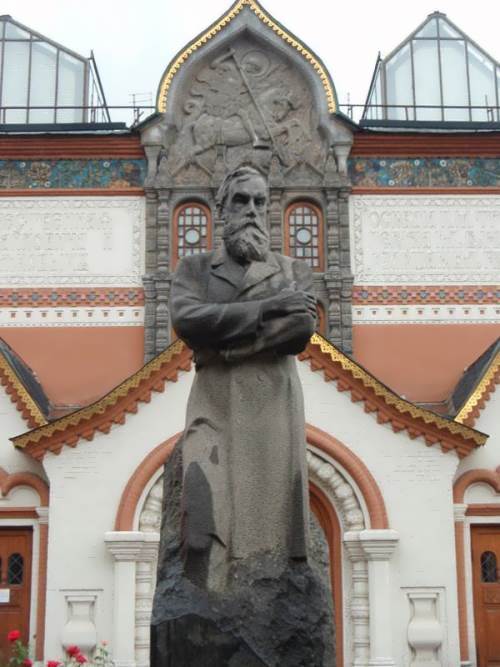Pavel Tretyakov and his Tretyakov Gallery
The world-famous Tretyakov Gallery is open to tourists all year round. However, not all visitors are familiar with the history of its creation, as well as the names of people, thanks to whom it appeared.
Pavel Tretyakov was born on December 27, 1832 in Moscow. The future collector was born into the family of a merchant. A very great influence on his life had a solid education, which Pavel and his brother received at home. From early childhood the brothers helped their father at work. The desire to help, and to expand the family business, was so strong that the young Tretyakovs became engaged in the production of paper. They became the owners of a paper mill with five thousand workers.
Pavel Mikhailovich was very kind, considerate, responsive. But at the same time, the simplicity and kindness of his heart were closely intertwined with real business acumen, the ability to highlight the main thing, perseverance. In addition to his main activity, Tretyakov was passionately fond of art. The young man decided to collect the best works of that era at all costs. Pavel Mikhailovich clearly understood the goals and the complexity of the work. It took him quite a lot of time. Since, in addition to his passion for art, Pavel and his brother were engaged in entrepreneurial activities, namely the management of the flax-spinning factory in Kostroma and the sale of paper and textiles.
You know, Pavel collected masterpieces not because of the desire for personal gain, success, authority, glory. On the contrary, he did everything he could to avoid any publicity about his collecting. Pavel Mikhailovich was forced to leave Moscow. After that the collector refused to attend the solemn ceremony of the transfer of the Tretyakov Gallery to Moscow property. This attitude to fame only confirmed that he was simple and humble man.
Little Pavel was excited by the noble idea of his own collection of art and thus opening the opportunity for compatriots to get closer to art. His dream was destined to come true. Already in 1856 he laid the foundation for his collection. The Russian national art was the most interesting for him. For a long time Tretyakov kept his collection in the offices, and in 1874 built a chic building for it. In 1881 the gallery was opened for free visiting.
To tell the truth, the collector never tried to buy extremely expensive exhibits for his collection. Most of the paintings had an average price. The main task at that time was to collect as much as possible works that would reflect the present national Russian art. Many paintings were painted by the Wanderers (Peredvizhniki). However, in addition to paintings, Pavel Mikhailovich was fond of sculpture and icons.
Tretyakov attended a lot of domestic and foreign exhibitions, where he bought paintings. In addition, the collector asked Russian artists to paint pictures for his gallery. Among these paintings there are many portraits, including famous Russian figures and rulers, scientists, writers, musicians, artists, artists, for example, Tolstoy, Dostoyevsky, Turgenev, Nekrasov, Goncharov, Tchaikovsky and other outstanding people.
In addition to the paintings bought by Pavel Mikhailovich the collection included those works that were collected and preserved by his brother. That collection consisted of the works of French artists. Until the middle of the twentieth century as many as 84 works were kept in the Tretyakov Gallery, and then they were transferred to the Hermitage and the Pushkin Museum.
In 1892 Tretyakov took a generous step and donated the entire collection to Moscow. At that time the collection consisted of more than a thousand paintings. The collection of Pavel Mikhailovich made it possible to systematize the works of the national school of painting, thereby setting the tone for the further development of Russian fine arts.
Thanks to his active charitable work Pavel strengthened the world significance of the Tretyakov Gallery. In 1893 the collector became a member of the St. Petersburg Academy of Arts. The gallery of Pavel Mikhailovich is very popular among tourists today. This only emphasizes the importance of his creation.
Tretyakov was friends with many artists and sponsored many of them. Also he actively supported special educational institutions, financially supported the widows of poor artists, as well as their children. He even took part in organizing a shelter for them.
Pavel Mikhailovich entered into Russian history as a real hero who did a lot for his Motherland and its prosperity. Moreover, many art critics characterize him as a true patriot of his country. Of course, it’s hard not to agree with this. After all, Pavel Mikhailovich’s goal was to collect as large collection of Russian works as possible. Moreover, Tretyakov had no artistic education, nevertheless he unerringly chose the best exhibits for his gallery.
Tretyakov died on December 16, 1898 in Moscow. His last words were: “Take care of the gallery and be healthy.” Pavel was buried at the Danilovsky cemetery in Moscow next to the parents. In 1948, the Tretyakov brothers’ ashes were reburied at the Novodevichy cemetery.





